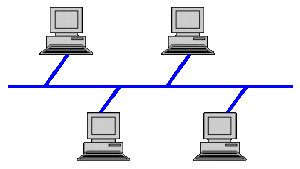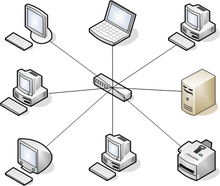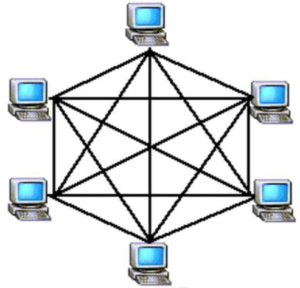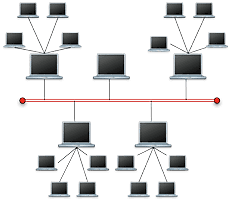What are some different types?
In the bus network topology, every workstation is connected to a main cable called the bus. Therefore, in effect, each workstation is directly connected to every other workstation in the network.
The bus topology exists when each of the systems is connected in a line, as seen in Figure n this topology, all the systems are chained to each other and terminated in some form on each end. This topology was used in the early days of networking because it was inexpensive to use and relatively easy to set up.
When a packet is sent in a bus topology, there is no intermediary to determine who the packet should go to. Because of this, every packet that is sent in a bus topology is received by all systems on the network. Normally, if the packet is not for a particular system, the computer would simply disregard the packet; however, you can see the security implications of this type of network. If a malicious user were on this network and utilized a packet capture program, he could see every conversation that occurred between machines.
Advantages Disadvantages
Easy to install Out-of-date technology
Costs are usually low If cable breaks, whole network is down
Easy to add systems to network Can be difficult to troubleshoot
Great for small networks Unmanageable in a large network
[tab:Star]
Star
In the star network topology, there is a central computer or server to which all the workstations are directly connected. Every workstation is indirectly connected to every other through the central computer.
In the bus and ring topologies, the systems in the network were connected to each other. In the star topology, instead of being connected to each other, the systems are now connected to some central device, as seen in Figure 2. In the star topology, one of the biggest advantages is that when one system goes down, it does not bring the rest of the network down with it as it does in the bus or ring topologies. The star topology is the most prevalent topology in use today.
Advantages Disadvantages
Easy to install Costs are usually higher than with bus or ring networks
Easy to add devices to network If you have only one central device and it fails, it brings the network down
One break does not bring whole network down
Easier to troubleshoot
Widely used
Centralized management
[tab:Ring]
Ring
In the ring network topology, the workstations are connected in a closed loop configuration. Adjacent pairs of workstations are directly connected. Other pairs of workstations are indirectly connected, the data passing through one or more intermediate nodes.
The ring topology exists when each of the systems is connected to its respective neighbour forming a ring, as seen in Figure 3. This physical topology has many of the same strengths and weaknesses of the bus topology. The main difference between the bus and ring is that the ring topology does not require termination. Because the systems are connected all together in a loop, there is no beginning and end point as there is with the bus topology. For additional fault tolerance or performance enhancements, you can add a second ring. This configuration is seen in Fibre Distributed Data Interface (FDDI) networks.
If a Token Ring protocol is used in a star or ring topology, the signal travels in only one direction, carried by a so-called token from node to node.
Advantages Disadvantages
Easy to install Out-of-date technology
Costs are usually low If cable breaks, whole network is down
Easy to add systems to network Can be difficult to troubleshoot
Great for small networks Unmanageable in a large network
[tab:Mesh]
Mesh
The mesh network topology employs either of two schemes, called full mesh and partial mesh. In the full mesh topology, each workstation is connected directly to each of the others. In the partial mesh topology, some workstations are connected to all the others, and some are connected only to those other nodes with which they exchange the most data.
In this layout, every system is connected to every other system. The main advantage of this topology is high availability. The main disadvantage of this topology is cost, both administrative and physical. Because each system is connected to each other, the amount of cabling and maintenance necessary can be prohibitive, especially in larger networks. The formula for determining the amount of cable needed in a mesh network is:
- • (N x (N – 1))/2, where N is the number of systems to be interconnected In our example in Figure 5, we have six systems that require 15 cables to create a mesh network. This topology is mainly used in Wide Area Network environments or in environments where high availability outweighs the costs associated with this amount of interconnection.
The internet is best described as a mesh network as all computers are interconnected in one way or another which enables such high availability and robustness.
Advantages Disadvantages
Extremely fault tolerant Expensive
Difficult to implement
Difficult to administer
Difficult to troubleshoot
[tab:Hybrid / Tree]
Hybrid or Tree
The tree network topology uses two or more star networks connected together. The central computers of the star networks are connected to a main bus. Thus, a tree network is a bus network of star networks. The hybrid or tree topology is simply a combination of the other topologies. Figure 5 shows an example of a hybrid network. In this layout, we have three star networks that are connected to each other through a bus topology shown by the red line.




